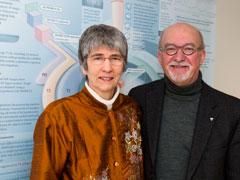Daylong Dash Through the Brain Sciences
By Jim Oldfield
Sunnybrook and Baycrest researchers gathered in Sunnybrook's McLaughlin Lecture Theatre on Thursday, January 8, for the inaugural Baycrest-Sunnybrook Neurosciences Research Day. More than 30 scientists presented their research, in 15-minute morning presentations and five-minute afternoon "speed talks."
The event provided attendees with an intensive overview of research at both sites, and a forum for collaboration among scientists at the two institutions, which share a productive partnership stretching back 20 years.
"I thought the day was a smashing success," said Dr. Donald Stuss, vice-president of research at Baycrest and a professor in the departments of medicine (neurology and rehabilitation science) and psychology at the University of Toronto. "Based on comments I heard, many people didn't know how much was going on not only in the other institution, but in their own. I think a lot of people were surprised at the depth and breadth of the research."
Participants heard talks on obesity and related disorders as risk factors for cognitive decline and dementia; hearing with two ears and how it changes with aging; and clinical trials on the psychological treatment of obsessive-compulsive disorders and continuation of antidepressant medication following traumatic brain injury. They also saw presentations on stroke, Alzheimer's disease and new imaging techniques that are enabling scientists and clinicians to translate brain sciences research into patient care, among others.
Dr. Sandra Black, director of brain sciences research at Sunnybrook Research Institute (SRI) who works closely with Stuss and other researchers at both institutions as Sunnybrook site director in the Heart and Stroke Foundation's Centre for Stroke Recovery, was also moved by the research showcased at the event. "There was some information overload, but it was truly impressive to see the work going on at our two sites. I hope some ideas for collaboration emerge from knowing what others are doing, and that people get new ideas for their own work," said Black, who is also a professor in the department of medicine (neurology) at the University of Toronto.
Attendance was strong throughout the day, peaking at about 100 after the two-hour lunch break, during which participants had a chance to network with each other and view research posters presented by young researchers from both sites.
Stuss, also an associate scientist in imaging at SRI, credits Black's Sunnybrook staff for organizing the event, together with administrators from Baycrest, and he and Black are looking toward next year's event to refine the presentation format. Stuss likes the evolving shift toward a model that favours short talks rather than long, noting that it is an effective structure for covering a lot of material. He and Black might incorporate time for some discussion between the speed talks next year, but Stuss said he's often surprised at how well short talks work, and this event was no exception. "Sunnybrook and Baycrest have had a wonderful relationship," said Stuss, "and this day was a good exemplar of the outcome of that relationship—something very tangible and positive."
PDF / View full media release »








